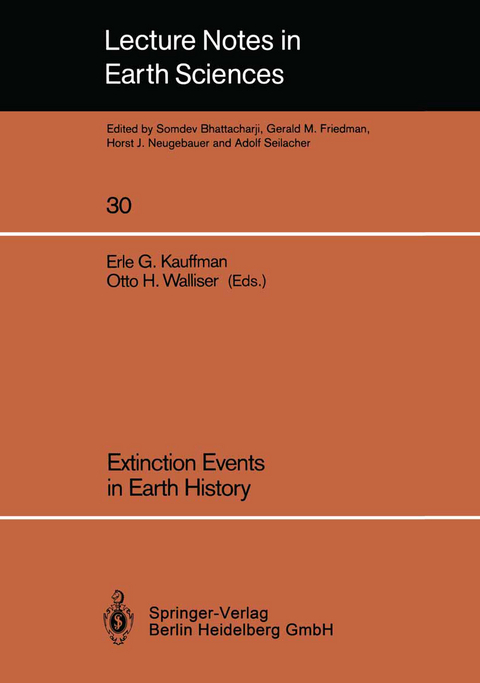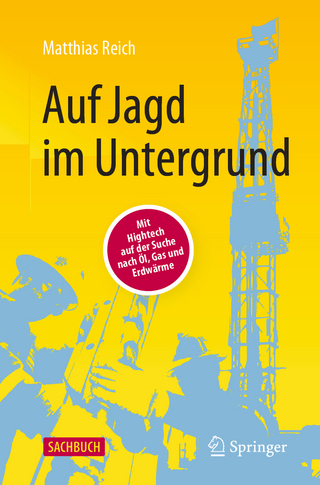
Extinction Events in Earth History
Springer Berlin (Verlag)
978-3-540-52605-6 (ISBN)
How to define "global bio-events".- Phanerozoic extinctions: How similar are they to each other?.- Biological selectivity of extinction.- A multi-causal model of mass extinctions: Increase in trace metals in the oceans.- Important considerations in the investigation of global bioevents.- Shock pressures in igneous processes: Implications for K/T events.- Vertical advection from oxic or anoxic water from the main pycnocline as a cause of rapid extinction or rapid radiations.- An astronomical explanation of anomalous concentrations of iridium element during catastrophic extinctions.- Evolutionary crisis within the Ordovician acrotretid inarticulate brachiopods of Poland.- Late Ordovician graptolite mass mortality and subsequent early silurian re-radiation.- Silurian and pre-Upper Devonian bio-events.- The Kacak-otomari event and its characterization in the Palentine domain (Cantabrian Zone, NW Spain).- The Middle Givetian pumilio-Events a tool for high time resolution and event-stratigraphical correlation.- The late Frasnian (Upper Devonian) Kellwasser Crisis.- The Frasnian-Famennian mass extinction record in the eastern United States.- Frasnian/famennian event in the Holy Cross Mts, Central Poland: Stratigraphic and ecologic aspects.- Late Devonian - Early Carboniferous paleobiogeography of benthic Foraminifera and climatic oscillations.- Major evolutionary events among the spiriferids at the Devonian-Carboniferous boundary.- The Permian-Triassic boundary revisited.- Mass extinctions in the fossil record of late Palaeozoic and Mesozoic tetrapods.- The relationship between extrinsic and intrinsic events in the evolution of Mesozoic non-marine Ostracoda.- The taxonomic analysis of mass extinction intervals: An approach to problems of resolution as shown by Cretaceousammonite genera (global) and species (Western Interior of the United States).- Patterns of survival and recovery following the Cenomanian-Turonian (Late Cretaceous) mass extinction in the Western Interior Basin, United States.- Trophic differences, originations and extinctions during the Cenomanian and Maastrichtian stages of the Cretaceous.- Originations, radiations and extinctions of Cretaceous rudistid bivalve species in the Caribbean Province.- Periodic bioevents in the evolution of the planktonic foraminifera.- Biogeochemical modeling at mass extinction boundaries: Atmospheric carbon dioxide and ocean alkalinity at the K/T boundary.- The fern-spore abundance anomaly at the Cretaceous-Tertiary boundary: A regional bioevent in western North America.- Palynological evidence of effects of the terminal Cretaceous event on terrestrial floras in western North America.- The Cretaceous-Tertiary boundary interval at south table mountain, near Golden, Colorado.- The Cretaceous-Tertiary boundary crisis at Zumaya (Northern Spain). Micropaleon-tological data.- Aftermath of the Cretaceous-Tertiary extinction: Rate and nature of the early paleocene molluscan rebound.- Species duration and extinction patterns in Cenozoic non-marine Ostracoda, Western United States.- Mammal extinctions in the Vallesian (Upper Miocene).
| Erscheint lt. Verlag | 30.5.1990 |
|---|---|
| Reihe/Serie | Lecture Notes in Earth Sciences |
| Zusatzinfo | VI, 433 p. 77 illus. |
| Verlagsort | Berlin |
| Sprache | englisch |
| Maße | 170 x 244 mm |
| Gewicht | 1 g |
| Themenwelt | Naturwissenschaften ► Geowissenschaften ► Geologie |
| Naturwissenschaften ► Geowissenschaften ► Geophysik | |
| Schlagworte | biological events • biologische Krisen • Erdgeschichte • Evolution • Geography • Massenaussterben • Mass extinction • Modelling • ocean • Oxide • Phanerozoikum • Sediment • Trias |
| ISBN-10 | 3-540-52605-6 / 3540526056 |
| ISBN-13 | 978-3-540-52605-6 / 9783540526056 |
| Zustand | Neuware |
| Haben Sie eine Frage zum Produkt? |
aus dem Bereich


